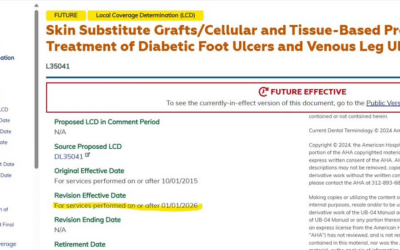Many Medicare Administrative Contractors (MACs) have policies currently in place that govern general wound care services in general. I am going to discuss the wound care policy that’s been in effect since 07/23/2020 for the Novitas jurisdiction. This policy specifically excludes topics like “skin substitutes” or hyperbaric oxygen therapy.
Even if you are not in the Novitas jurisdiction, it’s becoming obvious that these regional contractors share their policies and use the same language (sometimes with the same misspellings) from one region to another. I am going to focus on required documentation for wound care current required by Novitas, because it can serve as an example of the documentation that will likely be needed everywhere. There’s a lot on this policy, so you should read it yourself. I can only focus on a few major points. I will quote the policy in italics to distinguish it from my commentary and note that I am providing only portions of the text.
It is highly recommended that the treatment plan for a patient who requires frequent repeated debridement be reevaluated to ensure that issues including, but not limited to, pressure reduction, nutritional status, vascular insufficiency and infection control have been adequately addressed.
I’ve already discussed the fact that the chart has to state specific goals of treatment. This part of the policy discussed the treatment PLAN. Goals and plan of care are familiar concepts for nurses but not so much for doctors. However, this LCD states clearly in multiple places that the chart must have stated goals and that the treatment plan has to support those goals.
Note here that they are providing specific language about patients in whom debridement services are performed at regular intervals. Medicare and its contractors are watching this practice closely. If you are billing frequent debridements, you need to make sure you have addressed pressure reduction, nutritional status, vascular status and infection. While that sentence begins with “highly recommended” (and not “must”) – it would be wise for you to read it as “must.”
Overall, evaluation of the wound should be performed at a regular frequency to determine whether the individualized treatment goals are being met for the patient.
There it is again, the phrase “Individualized treatment goals.” Not only do you need to document the goals of therapy, but you need to document whether your treatments are achieving them. Those sentences may be small, but their implications are big.





